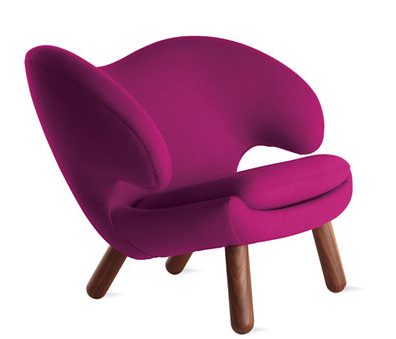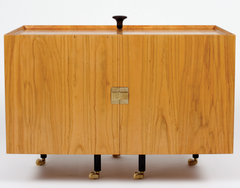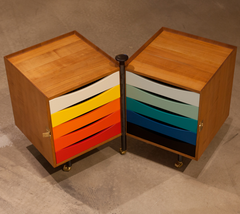Great Danish Designers 101: Finn Juhl
Finn Juhl is regarded as a leading figure in Danish mid-century design and described by many contemporary design experts as a “legend,” “master,” and “maverick.” He is also the first of the great Danish mid-century designers to have had his work promoted in North America, after a particularly successful show in Chicago that altered the course of his career.
Finn Juhl: The Pioneer Who Put Danish Design on the Map
Born near Copenhagen in 1912, Finn Juhl aspired to a career in art history. His father had other ideas, however, and convinced Juhl to enrol at the Royal Danish Academy of Fine Arts to study architecture.
Juhl worked as an architect for eleven years, alongside Vilhelm Lauritzen. While employed with Lauritzen, Juhl began experimenting with furniture design. He learned by doing and was completely self-taught. Eventually, he would partner with famed Danish cabinetmaker Niels Vodder in a working relationship that lasted until 1959. Together, Vodder and Juhl developed new methods of joining and bending teak and adding leather, cane, and upholstery to their designs. Their work would prove very influential to other designers of the period.
After the Second World War, Juhl set up his own design practice and began to gain recognition in Europe for his “exquisitely handmade” furniture which displayed a “refinement of teak jointing” and helped make teak the signature of Danish modern style. In fact, he was one of the first designers to use teak indoors. (Danish Modern)
He won multiple gold medals at the Milan Triennales during the 1950s, but it was a Chicago exhibit in 1951 that really put Juhl and Danish design on the map. Juhl designed an interior for the “Good Design” show that featured some of his furniture. From this single exhibit, he earned a commission from Michigan’s Baker Furniture to mass-produce furniture of a similar style. This line would consist of 24 pieces, including chairs, tables, sideboards, desks, and storage units. From here other important commissions followed. Juhl was asked to design: a DC-8 cabin for Scandinavian Airlines System, as well as over thirty of the airline’s ticket offices; Georg Jensen showrooms in New York, Toronto, and London; the Trusteeship Council Chamber in the United Nations headquarters in New York; and the interior of the Danish ambassador’s residence in Washington, D.C. (Scandinavian Modern Home, Scandinavian Modern) Eventually, Juhl’s designs would also be manufactured by Danish companies France & Son and Bovirke.
Stylistically, Finn Juhl stood apart from his contemporaries. He “embraced expressive, free-flowing shapes” in chair and sofa design before many of his colleagues. His “radically different” style proved controversial at first. He was considered somewhat avant-garde, drawing inspiration from sculpture more than historical design. (1stdibs, Danish Modern)
One of the best examples of this tendency is also one of his earliest designs: the Pelikan chair from 1940 which Juhl designed for his own home. In Scandinavian Modern Home, Elizabeth Wilhide refers to the Pelikan as a “radical interpretation of a wing chair” that shows the influence on Juhl of modern artists like Henry Moore, Picasso, and Alexander Calder. The Pelikan is being manufactured today by the House of Finn Juhl. One such version is shown below.
Image from Design Within Reach.
Another landmark design also emerged from Juhl’s own home furnishings in the same period. Like the Pelikan, the Poeten (or Poet) sofa, created in 1941, showed Juhl’s use of sculptural forms.
Image from 1stdibs.
As pioneers in the use of teak and leather, Juhl and his partner Niels Vodder created the now iconic Chieftain Chair. The Chieftain Chair was part of the collection created by Baker Furniture; the pair below are originals from the Baker line.
Image from 1stdibs.
Design Within Reach talks about why the Chieftain is so remarkable: with its “distinctive shapes inspired by primitive weaponry and a seat that appears suspended above the frame, the sculptural form of the Chieftains Chair…changed the future of Danish design.” Vodder and Juhl created only about 80 of these chairs; the rest were produced by Baker Furniture. Because of their relative scarcity, Finn Juhl designs by Vodder are among the most sought-after Danish designs from the mid-century period. (Danish Modern)
Equally iconic is the Model 45 Easy Chair, also known as the NV-45. Like the Chieftain, the seats of the NV-45 appear to float above the frame.
Image from 1stdibs.
In Scandinavian Modern Home, Wilhide describes the significance of this chair:
Images from House of Finn Juhl.
The beautifully designed cabinet swings open to reveal colour-coded drawers originally intended, it is said, to help his wife organize her many pairs of gloves.
A truly prolific artist, Juhl also designed ceramics, glassware, and teak bowls. His home still stands as a tribute to his many talents, furnished with his designs and accented with his own objets d’art, lighting, and custom bookshelves and cupboards. This seating area, featured in Dwell magazine, shows the Poet sofa and Chieftain chair in the Juhl home:
In a final nod to Juhl’s significance as a designer, Danish company One Collection secured the rights to his designs and, in 2011, began manufacturing reproductions of the Pelikan, Poet, Chieftain, NV-45, and Glove Cabinet, among many others. The collection is sold under the label The House of Finn Juhl and its range shows the incredible gifts of this architect turned cutting-edge furniture designer.
The next designer in our series: Kaare Klint, the father of Danish mid-century design.
Read more in this series: Johannes Andersen, Kai Kristiansen, Poul Cadovius, and Poul Hundevad.
This post was written by Crystal Smith of Pertingo Content Marketing.











Leave a comment